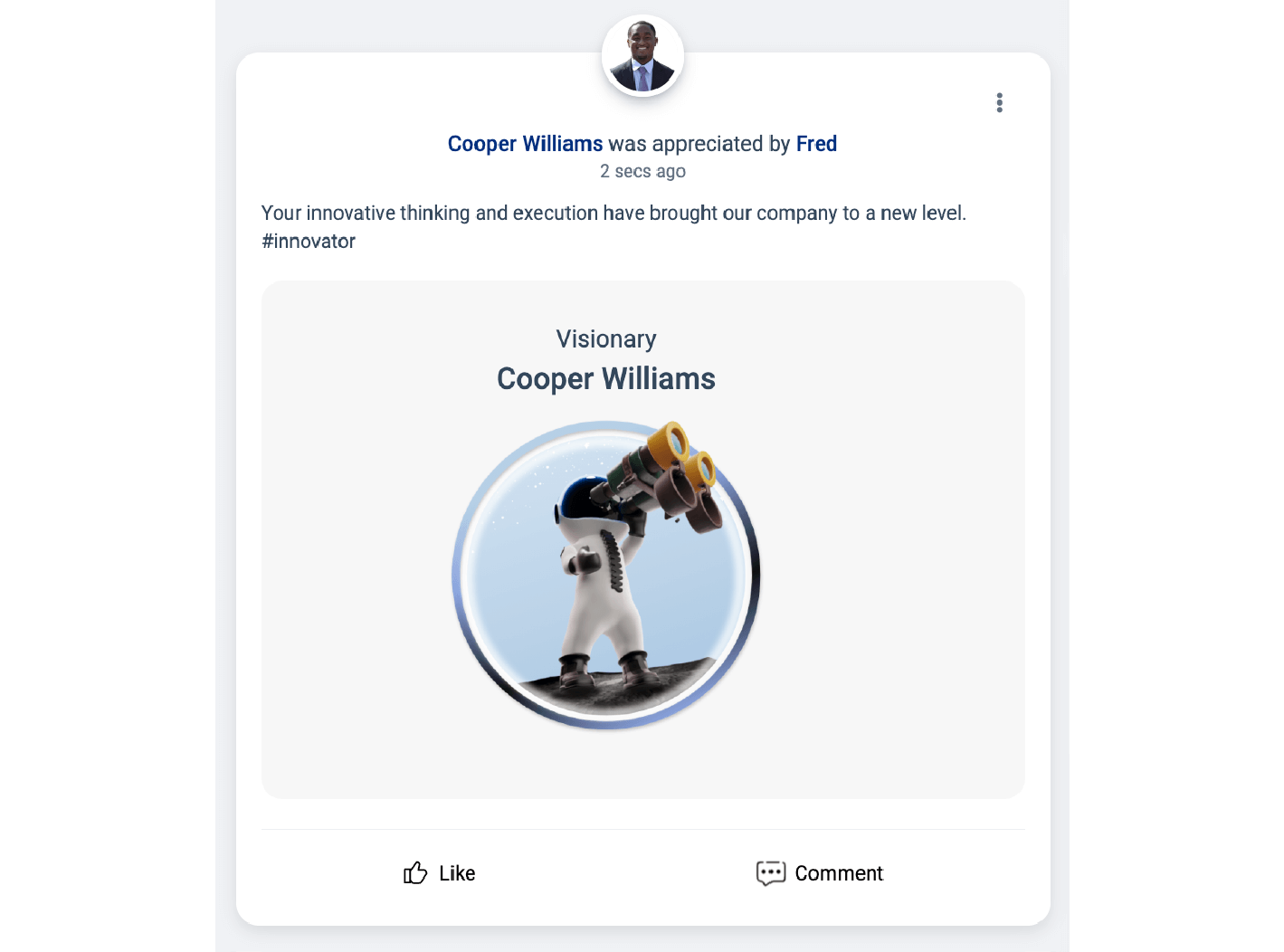6 Steps To Create An Amazing Employee Recognition Strategy
An employee recognition strategy is more than just a “nice-to-have"; it's a cornerstone of organizational success. This strategy goes beyond mere acknowledgments, embedding a culture of appreciation that aligns closely with company values and objectives.
In this blog, we will explore the goals, approaches, best practices, and more. We’ll also learn how to craft an effective step-by-step strategy, to boost employee recognition .
So, let’s dive in.
Key Takeaways
- Concept of Employee Recognition Strategy
- Employee Recognition Strategy Approaches
- Steps To Create An Employee Recognition Strategy
- How To Implement An Employee Recognition Strategy
- Employee Recognition Strategy Tips
Beyond Awards: Defining Your Recognition Goals

An effective employee recognition strategy is vital for building a positive workplace culture. Simple recognition tactics like praising good work boost employee morale, satisfaction, and loyalty to the company. This also greatly impacts retention rates and productivity over the long-term.
Studies show that a significant 83.6% of workers believe that being recognized for their efforts plays a crucial role in driving their motivation to succeed in their roles.
That is why crafting an intentional strategy for recognizing employees is crucial. It ensures that the appreciation efforts are thoughtful, regular, and support company goals.
But first, we need to define a clear set of goals that move beyond mere awards and acknowledgments. Let’s glance what they are -
1. Align Recognition with Company Values and Objectives
Ensure that your employee recognition program is in sync with your organization's mission and core values. This alignment motivates employees to embody these values in their day-to-day activities, reinforcing a cohesive company culture.
2. Identify Behaviors and Achievements Deserving Recognition
Recognize and celebrate actions that contribute significantly to the organization, such as -
- Going above and beyond the call of duty,
- Helping colleagues,
- Achieving milestones.
This acknowledgment encourages a culture of excellence and collaboration.
3. Consider Individual Preferences for Meaningful Recognition
You must understand that employees have different preferences and expectations while receiving recognition. While some may appreciate public praise during company meetings, others might value receiving additional responsibilities or private acknowledgment. Offering a variety of recognition methods ensures that the recognition feels personal and meaningful to everyone.
Now that you have understood about setting your recognition goals, let’s move ahead to the next phase.
How To Approach Employee Recognition Strategy?

There is no one way to approach employee recognition strategies for your organization. In order to maintain the consistency of your recognition strategy across all departments, you may look into these 3 approaches -
1. Day to Day Recognition
This involves acknowledging the small, everyday contributions of employees. It shows your employees that you notice and appreciate their work. Day-to-day recognition can be as simple as -
- Saying "thank you,"
- Giving shoutouts in team meetings,
- Sending personalized notes, etc.
Small gestures like these can really boost people's motivation and morale. The goal is to create a culture where showing appreciation is a regular part of working together.
A survey by Authentic Recognition found that only 2% employees receive daily recognition.
2. Formal Recognition
These are structured programs designed to recognize significant achievements and milestones. Awards mentioned below fall under this category -
- Employee of the month,
- Annual performance awards,
- Recognition for years of service.
The idea is to have official celebrations and events to publicly praise people for big achievements.
Studies show that companies with formal employee recognition programs experience 31% lower voluntary turnover compared to those without any such programs.
3. Informal Recognition
This type of recognition is less structured and can occur spontaneously. It includes -
- Peer-to-peer recognition,
- Casual mentions of “good work” during conversations,
- Small tokens of appreciation like gift cards, etc.
Informal recognition helps build a supportive and collaborative team environment by fostering personal connections and acknowledging the efforts in a more relaxed manner.
Creating a Winning Employee Recognition Strategy: A Step-by-Step Guide

1. Assess the Current Recognition Landscape
Begin your journey by thoroughly understanding the current state of recognition within your organization. You must gather insights into how employees feel about existing recognition practices. This can be done by conducting -
- Employee surveys,
- Focus groups,
- One-on-one interviews, etc.
This step is crucial for identifying what types of recognition are most valued. It also allows you to find gaps in the current system and areas for improvement.
Once you gather feedback about your workforce’s unique needs and preferences, it will serve as a baseline for tailoring your recognition strategy.
2. Develop a Comprehensive Recognition Framework
Based on the insights gained from your assessment, it’s now time to design a recognition framework. Make sure that the framework caters to a diverse workforce with varying preferences.
This framework should include a balanced mix of recognition types, such as -
- Immediate verbal thanks for day-to-day achievements,
- Digital shoutouts for project milestones, and
- Formal awards for significant accomplishments.
Ensure this framework aligns with your organizational values and goals, reinforcing behaviors that drive success. Incorporating various recognition forms ensures that every employee feels valued and recognized in a manner that resonates with them personally.
3. Establish Clear Objectives and Budget
Once you have developed the framework, proceed toward setting specific, measurable objectives for what your recognition program aims to achieve. For example, your organization’s aim could be to achieve -
- Increased employee engagement,
- Lower turnover rates, or
- Improved performance metrics, etc.
Alongside these objectives, establish a realistic budget that considers both monetary and non-monetary forms of recognition.
Your budget should account for the costs associated with -
- Implementing and maintaining the program including any technology platforms,
- Physical awards, and
- Event-related expenses.
Having clear objectives and a defined budget ensures that your recognition strategy is both goal-oriented and sustainable.
4. Implement a Recognition System
Empower your employees by implementing a recognition system that not only allows the leadership to award employees but also enables the employees to acknowledge each other's efforts and contributions directly.
This system could be facilitated through -
- A digital platform where employees can give each other virtual "high-fives" or
- Traditional methods like nomination boxes for "employee of the month."
Moreover, peer-to-peer recognition fosters a culture of appreciation across all levels of the organization and encourages teamwork and camaraderie.
Related: Employee Recognition and 6 Powerful Ways To Implement It
5. Communicate and Launch the Program
Effective communication is key to the successful launch of your recognition program. Once the recognition program is implemented, work on developing a communication plan. Your communication plan should clearly articulate three things -
- Purpose of the program,
- How it works, and
- How employees can participate.
Utilize various channels such as company-wide meetings, email newsletters, and intranet posts to ensure broad awareness. Engaging employees from the outset with clear, consistent messaging will drive participation and enthusiasm for the program.
6. Monitor and Iterate
Once your recognition program is in place, continuously monitor its effectiveness against your objectives. You must collect ongoing feedback from employees to gauge their satisfaction with the program and identify any areas for improvement.
Regularly reviewing program data and feedback will allow you to make informed adjustments. It will also ensure that the recognition strategy remains relevant, impactful, and aligned with evolving organizational needs and employee preferences.
Listen to this podcast to learn more about designing a winning employee recognition strategy from industry experts.
From Boardroom to Breakroom: Implementing Employee Recognition Strategies

While implementing recognition strategies, your goal should be to create a multifaceted recognition culture that resonates across all levels. This way, you are going to enhance employee engagement and satisfaction while boosting performance and supporting the organization's goals.
In the previous section, we discussed that a recognition system should allow the leadership and the employees to appreciate each other’s work. Let’s understand in detail about the types of recognition strategies that can be implemented in your organization.
Peer-to-peer Recognition
This form of recognition empowers employees to acknowledge the contributions of their colleagues directly.
A study shows that 28% of employees believe that peer recognition has the most impact in improving their performance.
Your organization can utilize tools like Slack channels or a dedicated employee recognition platform that allows for real-time, spontaneous expressions of gratitude and appreciation.

Source: Vantage Rewards
Such platforms can allow for sending of virtual badges, fostering a culture of recognition that is both inclusive and immediate.
This form of recognition democratizes and makes it accessible to everyone within the organization. It also encourages a positive work environment where contributions at all levels are valued.
Managerial Recognition
Managers play a crucial role in employee recognition. They do it by -
- Providing personalized feedback,
- Engaging in one-on-one meetings, and
- Extending handwritten notes to express appreciation.
This form of recognition is highly personalized and can be tailored to the individual's contributions and achievements. It reinforces the value of the work being done, boosts morale, and strengthens the manager-employee relationship.
Personalized feedback and recognition from a manager can also give employees a clear sense of their progress and development opportunities.
Company-wide Initiatives
Another type of recognition system that you can adopt is implementing company-wide recognition initiatives. These can be in the form of formal awards ceremonies to casual team lunches including but not limited to -
- Employee of the month awards,
- Team outings, or
- Social media shoutouts, etc.
These initiatives celebrate achievements across the entire organization. Moreover, they highlight individual and team successes, contributing to a shared sense of purpose and community.
Company-wide recognition plays a vital role in building a cohesive corporate culture that values and rewards contributions at all levels.
Igniting Recognition: Employee Recognition Strategy Tips

Now that you know how to implement an employee recognition strategy, let’s quickly glance at the best practices. These tips will allow you to ignite a powerful recognition culture that motivates employees, reinforces desired behaviors, and fosters a positive work environment.
1. Timeliness Matters
Immediate recognition of achievements significantly enhances its impact. Acknowledging contributions immediately reinforces positive behaviors and shows employees that their efforts are noticed in real-time.
2. Specificity is Key
Instead of offering generic praise, highlighting the specific actions, efforts, or contributions an employee has made. This approach personalizes the recognition and makes it more meaningful.
3. Inclusiveness Counts
A successful recognition program encourages participation across all levels and departments, fostering a sense of unity and belonging. It's important to create opportunities for recognition that are accessible to everyone, regardless of their role or level within the company.
4. Celebrate Wins Publicly
Sharing success stories publicly within the organization amplifies the impact of recognition. It not only celebrates the individual or team achievements but also inspires others by showcasing examples of what can be accomplished.
5. Address Challenges
You are bound to face many challenges while implementing recognition strategies. For example, budget constraints should not be a barrier to recognition. There are many creative, low-cost recognition options that can have a significant impact. The key is to understand what your employees value and to tailor recognition efforts to align with those values.
Reaping the Rewards: Final Words
By now, it's clear that a strong employee recognition strategy is key to building a happier and more productive team. It's about ensuring everyone feels valued for their hard work and contributions. This simple approach boosts morale and strengthens the bond within the team, making the workplace a better environment for everyone.
As we move forward, let's remember the power of saying 'thank you' and recognizing each other's efforts.

















